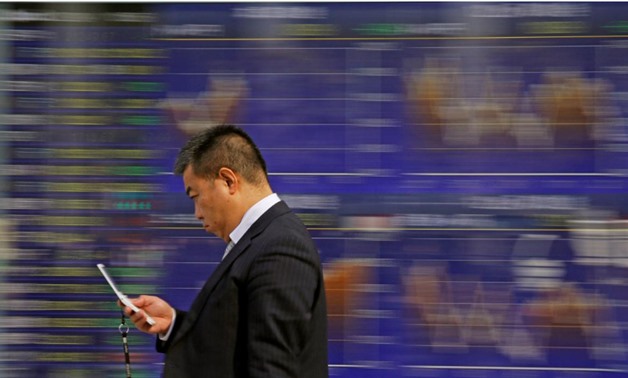
A man walks past an electronic stock quotation board outside a brokerage in Tokyo, Japan, February 9, 2018. REUTERS/Toru Hanai
TOKYO - 21 February 2018: Asian stocks gained on Wednesday, while the dollar advanced as traders near-term focus shifted to the minutes of the Federal Reserve’s last policy meeting for hints on the future pace of U.S. monetary tightening.
But spreadbetters expected European stocks to follow Wall Street’s lead and open lower, with Britain’s FTSE slipping 0.3 percent and Germany’s DAX and France’s CAC losing 0.6 percent.
MSCI’s broadest index of Asia-Pacific shares outside Japan rose 0.7 percent after slipping earlier in the session following the U.S. market losses, which snapped a six-session winning streak.[.N]
“Some investors in (Asia) are returning from the Lunar New Year break and trying to catch up after seeing the U.S. share markets make gains during their absence,” said Kota Hirayama, senior market economist at SMBC Nikko Securities in Tokyo.
“If Chinese shares rise when trading resumes tomorrow, that could lift the region further.”
Trading in Chinese financial markets will resume on Thursday after being shut for the past week for the Lunar New Year.
Japan’s Nikkei trimmed earlier gains but held on to end the day 0.2 percent higher.
Australian stocks were nearly flat and South Korea’s KOSPI gained 0.55 percent. Hong Kong’s Hang Seng rose 1.2 percent.
U.S. Treasury yields rose as the bond market braced for this week’s $258 billion deluge of new government debt. The two-year bill yield touched 2.282 percent, the highest since September 2008. [US/]
Increased government borrowing has applied steady upward pressure on Treasury yields. The Treasury Department has issued more debt in anticipation of a higher deficit from last year’s major tax overhaul and a budget deal that will increase federal spending over the next two years.
The dollar benefited from the higher yields, with its index against a basket of six major currencies edging up to a one-week high of 89.904.
The index has bounced 0.9 percent so far this week after slumping 1.5 percent the previous week to a three-year low.
The U.S. currency has been weighed down by a variety of factors this year, including concerns that Washington might pursue a weak dollar strategy and the perceived erosion of its yield advantage as other countries start to scale back their easy money strategies.
Confidence in the dollar has also been shaken by mounting worries over the U.S. budget deficit.
But the greenback managed to find bids once the dust began to settle after last week’s tumble.
“We are seeing the dollar being bought back after last week’s slide. The steady U.S. economy and the possibility of the Fed accelerating its rate increases will likely keep fuelling the dollar’s rebound, particularly against the euro and yen,” said Masafumi Yamamoto, chief currency strategist at Mizuho Securities in Tokyo.
Later on Wednesday, investors will turn their attention to the minutes of Fed’s last policy meeting in late January. Analysts said a hawkish tone to the minutes could prompt markets to price in the risk of a faster U.S. interest rate hikes and help lift the dollar further.
The dollar extended an overnight surge and gained 0.45 percent to 107.800 yen. The euro fell 0.1 percent to $1.2323 following losses of 0.55 percent the previous day.
The Australian dollar lost 0.4 percent to $0.7852 and the New Zealand dollar dipped 0.2 percent to at $0.7333.
The stronger dollar weighed on commodities, with Brent crude futures losing 0.8 percent to $64.73 per barrel and U.S. crude oil futures slipping 1 percent to $61.15.
U.S. crude hit a near two-week high the previous day on news of inventory declines at a key storage hub and from expectations that top OPEC producers could extend cooperation beyond 2018.
Spot gold touched a one-week trough of $1,327.90 an ounce, having declined 1.4 percent so far this week.

Comments
Leave a Comment